Miyajima, also known as Itsukushima, is a captivating island that offers visitors a glimpse into Japan’s rich spiritual heritage. This audio guide explores the island’s revered Shinto sites, including the iconic floating torii gate of Itsukushima Shrine, and the harmonious coexistence of Shintoism and Buddhism at Daigan-ji Temple. From the tranquil Henjokutsu Cave at Daisho-in to the panoramic vistas of the Misen Observatory, the guide immerses travelers in Miyajima‘s natural splendor and cultural experiences, making it a must-visit destination to uncover Japan’s spiritual essence. Where will this journey through Miyajima’s sacred landscapes lead you?
Key Points

-
Itsukushima Shrine, a revered Shinto site on Miyajima Island, features a floating torii gate and serene architecture harmonizing nature and human creation.
-
Daigan-ji, a Buddhist temple, showcases the coexistence of Shintoism and Buddhism on the sacred land through its architecture, artwork, and rituals.
-
Daisho-in’s Henjokutsu Cave, a natural formation, offers a tranquil and introspective experience with stone Buddhas and religious statues.
-
Misen Observatory atop Misen mountain provides panoramic views of Miyajima’s breathtaking natural landscapes, including the iconic Itsukushima Shrine.
-
Omotesando Shopping Street immerses visitors in the island’s cultural traditions through local crafts, delicacies, and shrine-inspired souvenirs.
Revered Itsukushima Shrine
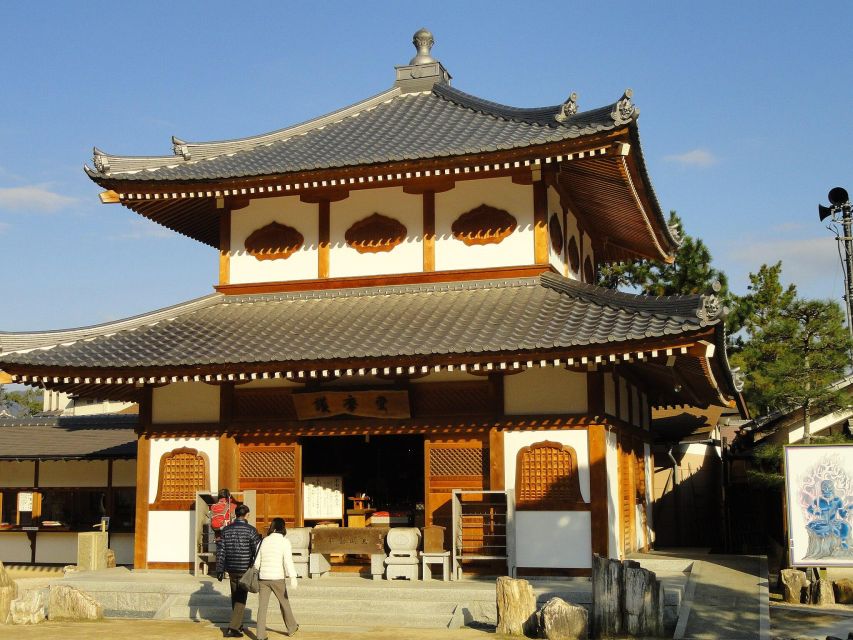
The Itsukushima Shrine is considered a revered Shinto place of worship for several reasons:
The shrine is located on the island of Miyajima and is renowned for its iconic floating torii gate and main sanctuary that appear to sit atop the water during high tide. This unique setting creates a breathtaking and spiritual atmosphere, making the shrine one of Japan’s most photographed and iconic sites.
The shrine’s history dates back to the 6th century, and its architecture and design are a testament to the harmony between nature and human creation. Visitors can explore the shrine’s main hall, secondary shrines, and scenic walkways, all while taking in the serene beauty of the surrounding landscape and Seto Inland Sea.
Loving the local insights? Here are more guided experiences we recommend in Hiroshima
Daigan-ji: Shintoism and Buddhism
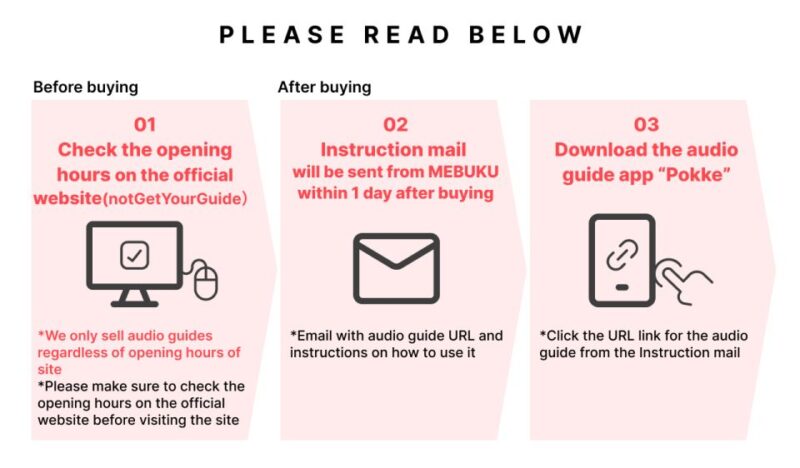
Daigan-ji, a Buddhist temple located on Miyajima Island, showcases the coexistence of Shintoism and Buddhism on the sacred land.
The temple’s origins date back to the 6th century, and it’s one of the few places where visitors can witness the harmonious integration of the two major spiritual traditions.
Daigan-ji’s architecture, artwork, and rituals blend Shinto and Buddhist elements, reflecting the island’s unique spiritual heritage.
Visitors can explore the temple’s serene gardens, admire its intricate carvings, and participate in various ceremonies that highlight the syncretic nature of Miyajima’s religious landscape.
The temple stands as a testament to the island’s rich cultural and spiritual tapestry, inviting travelers to enjoy its captivating blend of beliefs.
Daisho-in’s Henjokutsu Cave

One of the standout features at Daisho-in, the 14th temple in the Chugoku 33 Kannon Pilgrimage, is the captivating Henjokutsu Cave, which offers visitors a unique spiritual experience.
This natural cave formation is believed to have been created by Kobo Daishi, the founder of Shingon Buddhism.
As visitors make their way through the dimly lit cavern, they’ll encounter a series of stone Buddhas and other religious statues, creating an atmosphere of tranquility and introspection.
The Henjokutsu Cave is a testament to the spiritual significance of Daisho-in, inviting travelers to take a moment of pause and reflect on the island’s deep-rooted connection to Japanese Buddhist and Shinto traditions.
Misen Observatory’s Panoramic Views
Atop the picturesque Misen mountain, the observatory offers visitors a panoramic vantage point to behold Miyajima’s breathtaking natural landscapes.
The Misen Observatory sits at an elevation of 535 meters, providing visitors with sweeping views of the island’s forests, the Seto Inland Sea, and the distant peaks of the Chugoku Mountains.
On a clear day, the iconic Itsukushima Shrine and its famous floating Torii Gate can be seen in the distance.
Accessible by hiking trail or ropeway, the observatory is a must-visit attraction for those seeking to fully appreciate Miyajima’s stunning natural beauty from an elevated perspective.
More Great Thing To Do NearbyOmotesando Shopping Street Attractions
Winding its way through the heart of Miyajima Island, Omotesando Shopping Street offers visitors a delightful array of local crafts, delectable delicacies, and cultural experiences.
As you stroll along this charming promenade, you’ll discover:
-
Traditional handicrafts: From intricate woodcarvings to delicate lacquerware, the local artisans showcasing their wares provide a glimpse into the island’s rich artistic heritage.
-
Savory street food: Indulge in Miyajima’s famous grilled oysters, okonomiyaki (savory pancakes), and other delectable local specialties that tantalize the taste buds.
-
Shrine-inspired souvenirs: Browse the shops for unique souvenirs, such as amulets, charms, and trinkets inspired by the island’s revered Shinto shrines and Buddhist temples.
Omotesando Shopping Street is a vibrant cultural hub that allows visitors to enjoy the traditional and contemporary aspects of Miyajima’s charming island atmosphere.
Here are more great tours and experiences we've reviewed in Hiroshima
Itsukushima Shrine’s Main Sanctuary
The Itsukushima Shrine‘s main sanctuary, known as the Honden, stands as the centerpiece of this iconic World Heritage Site.
Constructed entirely on stilts over the Seto Inland Sea, this magnificent wooden structure exemplifies the harmonious coexistence of the island’s Shinto and Buddhist traditions.
Visitors are awestruck by the shrine’s elegant design, featuring sweeping roofs and intricate carvings that blend seamlessly with the serene natural surroundings.
The Honden is the primary place of worship, where visitors can observe Shinto rituals and ceremonies.
As the heart of the Itsukushima Shrine complex, the main sanctuary offers a profound connection to Japan’s rich cultural heritage and spiritual legacy.
Itsukushima Shrine’s Famous Torii Gate
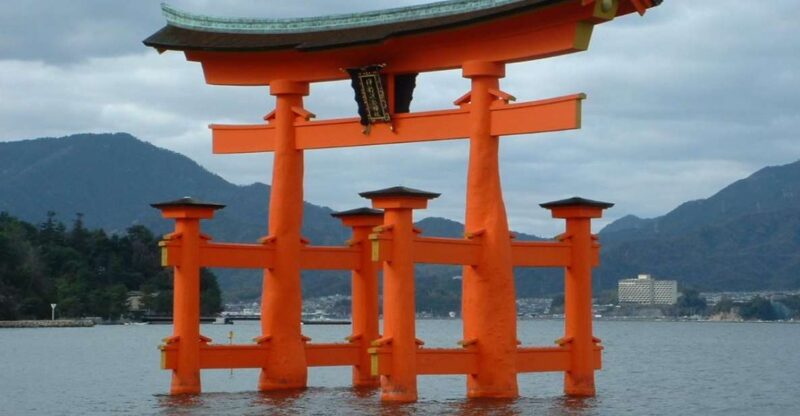
Undoubtedly, the iconic torii gate of Itsukushima Shrine is one of Japan’s most recognizable and photographed landmarks.
Situated partially in the Seto Inland Sea, this massive vermilion-colored gate appears to float on the water during high tide, creating a captivating and ethereal visual.
The torii gate serves as the entrance to the sacred Shinto site, symbolizing the transition from the profane to the sacred.
The current torii gate dates back to 1878, although the shrine’s history dates back to the 6th century.
The gate is made of cast iron and stands an impressive 16 meters tall.
Visitors can walk through the gate during low tide, creating a unique perspective for photography.
Highlights of the Audio Guide
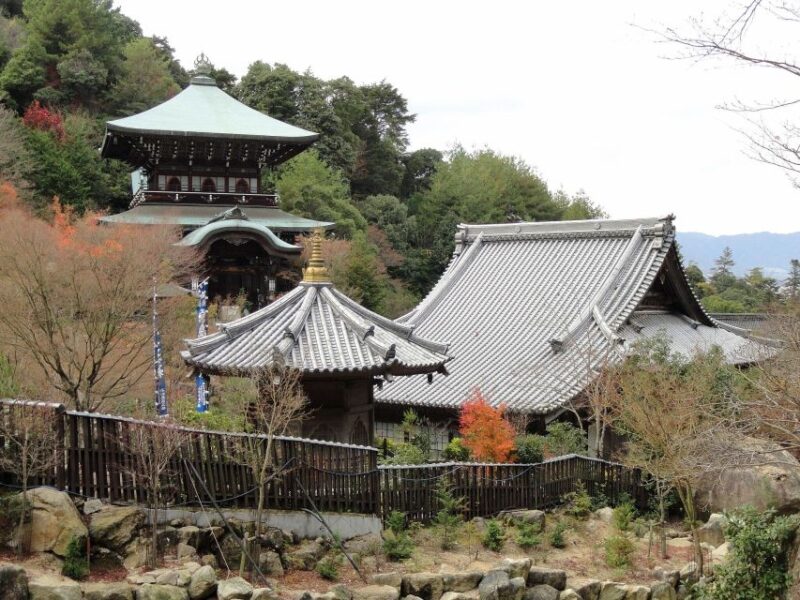
Exploring the Itsukushima Shrine, visitors encounter a captivating array of architectural and cultural wonders meticulously covered in the comprehensive audio guide.
The guide doesn’t stop there, however, also delving into the nearby Daigan-ji and Daisho-in Buddhist temples, which showcase the coexistence of Buddhism and Shintoism.
For those seeking panoramic views, the Misen Observatory is a must-visit destination highlighted in the audio tour.
Rounding out the experience is a stroll along the Omotesando Shopping Street, where travelers can enjoy the local culture and pick up unique souvenirs.
With a runtime of 50 minutes, this audio guide provides a well-rounded exploration of Miyajima Island’s spiritual and tourism highlights.
Frequently Asked Questions
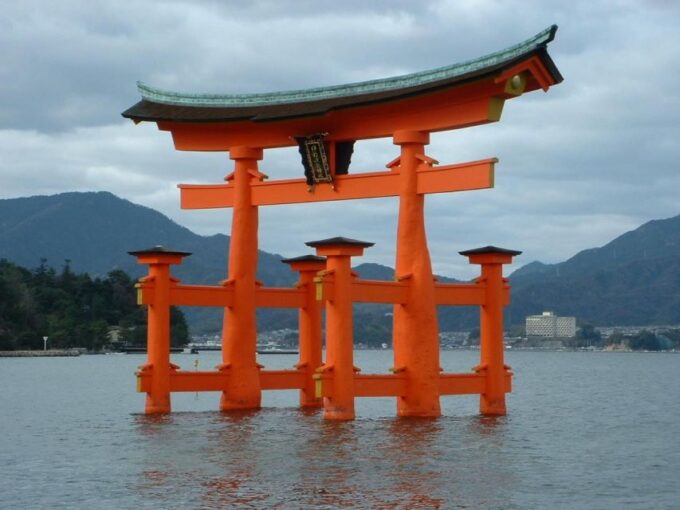
What Is the Best Time of Year to Visit Miyajima Island?
The best time to visit Miyajima Island is during spring or fall. Spring offers beautiful cherry blossoms, while fall showcases vibrant autumn foliage. Crowds are smaller, and temperatures are mild, making it an ideal time to explore the island’s spiritual and natural wonders.
Can Visitors Stay Overnight on the Island?
Yes, visitors can stay overnight on Miyajima Island. The island has several hotels, inns, and ryokans that allow visitors to experience the island’s serene atmosphere after the day-trippers have departed.
Are There Any Special Events or Festivals Held on the Island?
Miyajima Island hosts several annual festivals and events. The most famous is the Kangensai Festival in August, featuring traditional music and dance performances. Other events include the Spring Cherry Blossom Festival and Autumn Foliage Illuminations.
How Accessible Is the Island for Individuals With Disabilities?
The island is reasonably accessible, with paved paths, wheelchair-friendly facilities, and transportation options. However, some areas may present challenges due to the island’s hilly terrain and historic architecture. Visitors with disabilities should check accessibility details before planning their visit.
What Are the Transportation Options to Reach Miyajima Island?
Visitors can reach Miyajima Island by taking a short ferry ride from Miyajimaguchi Pier on the mainland. The ferry service operates regularly throughout the day and provides a scenic trip across the Seto Inland Sea.
Recap
Miyajima’s spiritual essence captivates visitors through its rich Shinto and Buddhist heritage.
The iconic floating torii gate, tranquil Henjokutsu Cave, and panoramic Misen Observatory vistas immerse guests in Japan’s cultural tapestry.
From the harmonious Daigan-ji Temple to the lively Omotesando Shopping Street, this audio guide showcases Miyajima’s multifaceted allure as a must-visit destination to explore the country’s spiritual heart.
You can check if your dates are available here:More Guided Tours in Hiroshima
- Hiroshima & Miyajima Tour With English/Spanish Speaker Guide
- Onomichi 9hr Private Tour – Hiroshima DEP. With Licensed Guide
- Hiroshima With Goverment Certified Tour Guide and Transportation
- Hiroshima Guide Take You to Two World Heritage Sites in Hiroshima
- 5 Hours Hiroshima Highlights Tour With Professional Guide
- Hiroshima: Hiking Guide Tour With Open-Air Tea Ceremony
More Tour Reviews in Hiroshima
Not for you? Here's more things to do in Hiroshima we have recnetly reviewed
- 2 Best Dining Experiences In Hiroshima
- 2 Best Dinner Tours In Hiroshima
- 6 Best Full-Day Tours In Hiroshima
- 4 Best Lunch Experiences In Hiroshima
- 11 Best Food Tours In Hiroshima
- Hiroshima and Miyajima by Bike and Boat
- 5-Day ONE WAY Bus to North Hyogo From Fukuoka to Hiroshima
- Japan: 7-Day Tour of Tokyo, Osaka, Hiroshima & Okinawa
- 3-Day ONE WAY Bus Tour to Hiroshima via SANIN From Fukuoka
- Hiroshima Highlights Private Day Tour
- Hiroshima and Miyajima Day Trip From Kyoto/Osaka
- From Osaka/Kyoto: Hiroshima & Miyajima Private Guided Tour
